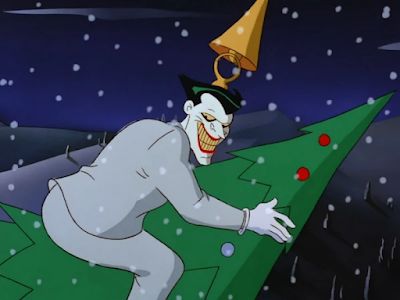OK. One detour before the next episode since we're starting up again. One of the features on the Blu-Ray set is the inclusion of the original promo reel that Bruce Timm and Eric Radomski created as the official pitch to the studio for The Animated Series. This is the general concept of the storytelling and visual styles that they planned to use and you can see why the studio, already eager to begin a Batman project by recruiting Timm, were convinced that they had found the right person to do it.
This video has been around in bootleg form for quite some time, but ordinarily the sound file isn't connected to it and that's the case on the Blu-Rays, as well. But this user on YouTube found the soundtrack and synced it properly so we're not just listening to the theme music, but the actual delivery of the moment as Timm and Radomski first presented it. You can see all of their main visual themes in this two-minute clip: the darkness of the overall picture, the red skies of Gotham, the menacing portrayal of The Batman, including the painted still at 0:59. There's a bit of variation, in that the moments immediately following that still showing our hero dodging gunfire uses a more "toony" approach than the rest of the series did, with The Batman showing Bugs Bunny-like agility in his motion. But the moment where the camera pulls back to show the literally larger-than-life combat between The Batman and the gangster at 1:25, as their shadows on the wall display the Caped Crusader's effort for the entire city to see, is every bit the kind of story that Timm and Radomski meant to tell. Speaking of Bugs, the full orchestra behind the music of the series is also something that the producers wanted in order to get closer to that cinematic effect, just like those Warner Bros. classics.
It was Radomski who came up with the idea of painting all of the backgrounds on black paper in order to maintain that darkness. In fact, some of the early episodes were so dark that they apparently hit the technical limit for broadcast, since it affects the overall picture. And you can see that in the case of the first episode they worked on and released, which is the second episode I reviewed: On Leather Wings. That one has it all: the red skies, the darkness, the elaborate animation style that is evident in the promo reel above. There's also a highlight where the Man-Bat, with The Batman in town, flies along the length of one of those police airships. Timm said the shot was so complex that they were afraid the director, Kevin Altieri, wouldn't be interested, since it would be easy for a lot of viewers to lose the flow of the action. But Altieri signed right onto it, which confirmed to Timm and Radomski that they had a guy who would go on to become a key member of the team in a lot of different functions.
That also meant directors that were flexible, since most of the scripts for the episodes were shorter than typical TV animation scripts, which map out every action and camera change. These scripts were done in more "Marvel style", echoing the rival comic publisher's approach to comic scripting, in which the writer sends a detailed plot and leaves the pace and camera angle up to the artist, before returning to script (dialogue) the action. The studio hated it, because there was less detail for them to object to, so they didn't know what was coming. But that's what happens when you don't know where the Darknight Detective will appear next-! One other detail that Timm revealed about On Leather Wings is that it's the first and last time that The Batman appeared in the series with blood on his face (from a rough landing.) That's one thing the censors objected to and which wouldn't happen again.
OK. Next time for sure: See No Evil.

















